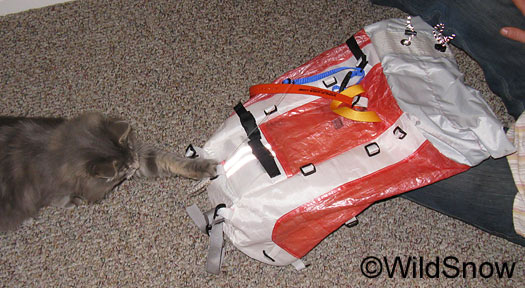Ever since the first time I winched my 4,000 pound Jeep over a Moab ledge with finger-thin thermoplastic rope instead of steel cable, I’ve been convinced that an ultra high molecular weight polyethylene formulations (UHMWPE; Spectra, Dyneema) are viable materials for constructing just about anything that requires ultimate durability (though they still have their weaknesses, such as less heat resistance).
Consider rucksacks. In my recollection, Kelty was the first pack company to make a bag using UHMWPE, when in 1994 (or perhaps earlier) they began selling models built with Spectra fabric. These packs were a huge help to alpine climbers who needed large volume, but for whom even a few pounds of weight could mean the difference between life and death. (Ergo, save a few pounds of pack weight, carry more fuel and food to yield that one critical extra day of climbing or retreat.)
Since Kelty’s innovation, various pack makers have dabbled in building sacks using woven versions of UHMWPE, and conventional nylon reinforced with same. We love ’em all, as the combo of durability and weight savings this material provides continues to awe.
But how about taking it up a notch? Or at least doing something different? Last summer the rucksack geek squad at Cilogear introduced backpacks made with non-woven UHMWPE, or specifically, non-woven Dyneema (NWD). This stuff is essentially just sheet material you could make plastic bags out of if you wanted to — only of course a zillion times stronger than what they sell at the grocery store.
So, even though Cilogear is a climbing pack company, there really isn’t all that much difference between any good 30 liter range alpine pack and the configuration of ski pack I like (simple top loader rigged with diagonal ski carry), so I’ve been working with Cilogear to get WildSnow set up with their NWD 30 Worksack. I picked the bag up at the OR tradeshow and I’ll be using it as my non-Avalung mid sized pack, both winter and summer.
There are ski packs as light as the NWD 30, but they’re not nearly as durable. I’ve used various versions, and once you go beyond simple ski touring you’re liable to get rock burns and cuts from your ski edges in anything made with thinner nylon. So the idea with my NWD 30 is it’ll simplify my life by working for nearly everything I do, as well as not requiring the care and thought that a conventional pack demands. In other words, you don’t have to baby it.
For example, a few years ago Bob Perlmutter and I were exploring the Kilpacker Creek approach for El Diente peak in Colorado’s San Juans. We got into an a bit of unplanned 4th/5th class rock climbing, and one section of ridge was so awkward that after Bob led it I decided to clip my pack onto the rope and slide it over to him, skis and all, so I could do the exposed ridge scramble more safely. One drag over the rocks like that, and my conventional fabric pack sustained significant damage. It was replaced long ago. A UHMWPE pack would probably have come out unscathed.

Max provides our most sophisticated and brutal pack durability test yet, passed by Cilogear NWD 30 Worksack. Once you wear it out after 10 years of skiing, convert to a cat scratching post for the next century.
NWD is about 20% lighter than woven versions of UHMWPE but slightly less abrasion resistant. That might matter to rock climbers, but for a ski pack the NWD is still so strong that subtle differences are hardly worth the time it took to write this sentence. Non-woven also costs a bit less, but it’s not exactly easy to construct pack with so any cost savings probably get canceled out.
Interestingly, while researching this subject I noticed that ski P-tex is actually something similar to UHMWPE, or perhaps the same thing only in yet another form. Anyone know the details about that? Clyde?
I’ll file a more extensive review after I’ve set the Cilogear up for skiing and used it for a while. (Same with weight, as I’m not sure how it’ll be set up yet, so I don’t have final weight.) And yes, the 30 Worksack is about 4 times the cost of a normal 30 liter class ski pack, but what if it lasted far far longer? For a guide or someone in the 100-days-skiing-a-year activity class, the cost could easily amortize due to fewer replacements. And if you’re a ski alpinist doing rock scrambles and rope work, a UHMWPE pack is perhaps an essential.
Only crux now is to convince Cilogear to build a dedicated ski pack.Click on over there via this link so they know we’re out there. Waiting.
WildSnow.com publisher emeritus and founder Lou (Louis Dawson) has a 50+ years career in climbing, backcountry skiing and ski mountaineering. He was the first person in history to ski down all 54 Colorado 14,000-foot peaks, has authored numerous books about about backcountry skiing, and has skied from the summit of Denali in Alaska, North America’s highest mountain.

